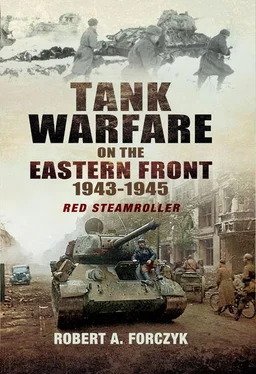Operation Suvorov : the Smolensk Offensive, 7 August–2 October 1943
In addition to Kutusov and Rumyantsev , the Stavka had also been planning to mount a major summer offensive toward Smolensk once Operation Zitadelle was defeated. General Vasily D. Sokolovsky’s Western Front had already contributed its 11th Guards Army and a good portion of its armour to Operation Kutusov in mid-July, but the Stavka wanted to use the rest of this front’s resources against the centre of Heeresgruppe Mitte’s line. General-Polkovnik Andrei I. Eremenko’s Kalinin Front would also make forces available for a push toward Smolensk. Stalin took great interest in the planning of the Smolensk offensive and it was named Operation Suvorov after one of Russia’s greatest generals to indicate the importance of the task. Since Zhukov and Vasilevsky were supporting Kutusov and Rumyantsev , Marshal of Artillery Nikolai N. Voronov was sent as Stavka representative to coordinate Suvorov .
With his two tank corps committed to Operation Kutusov , Sokolovsky’s only remaining large mechanized formation was General-leytenant Mikhail V. Volkhov’s 5th Mechanized Corps (5 MC), but he also had five tank brigades and four tank regiments that could be allocated for Suvorov . Since many of these units were well under-strength from previous combat, Sokolovsky received 298 new tanks in July to replenish his armoured units. Eremenko contributed a heavily-reinforced 39th Army with three tank units to Suvorov , so he received only 70 tank replacements. Altogether, the Western Front committed about 1,280 tanks and 45 self-propelled guns to the offensive and Kalinin Front committed 110 tanks. Both fronts were still using considerable numbers of Lend-Lease tanks (Matildas and Valentines) as well as older tanks like the T-60. In order to clear enemy obstacles, the Western Front received four sapper brigades and two more went to the Kalinin Front. The only serious deficiency in the preparation for Suvorov was in logistics; although 3–5 basic loads of tank and artillery ammunition had been stockpiled, the amount of fuel available was only 1.3 loads, which was grossly inadequate for a breakthrough operation. {165} Given that the Western Front quartermasters had been primarily supporting positional warfare for the past 18 months, they do not appear to have been ready to shift to supporting mobile operations.
On the German side, Generalfeldmarschall Günther von Kluge’s Heeresgruppe Mitte was very weak in armoured resources but had the advantage of well-prepared defences in depth. Generaloberst Gotthard Heinrici’s 4.Armee (AOK 4), which was the main target of Operation Suvorov , had been holding the sector of the front between Yartsevo and Spas-Demensk since Operation Typhoon failed in 1941. Heinrici’s troops had built multiple lines of fieldworks that represented a 12–15km deep defensive network that included anti-tank ditches, mines, barbed wire obstacles and reinforced wooden bunkers. Here, the German troops had sufficient time and resources to build very deep trenches that could survive all but the heaviest artillery bombardments and the obstacle belts were thick and covered by fire. The terrain also favoured the defence, with thickly wooded areas and swampy rivers that were difficult for tanks to cross. While not impregnable, Heinrici’s defence was formidable. The only real problem facing Heeresgruppe Mitte was the lack of reserves. Heinrici’s AOK 4 consisted of 12 infantry divisions that were well under-strength and most replacements were going to von Manstein’s command. Since von Kluge had provided Model’s AOK 9 with all his Panzer-Divisionen, the only mobile reserve left was Generalleutnant Werner von Erdmannsdorff’s 18.Panzergrenadier-Division; this unit only had a combat strength of 3,000 troops and a few attached assault guns, which left it ill-equipped to seal off any Soviet breakthroughs, should they occur. {166} Von Kluge had retained some assault gun units and he provided Heinrici with elements of three Sturmgeschütz-Abteilungen, totalling about 60 StuG IIIs.
Sokolovsky decided to make his main attack against the Yelnya-Spas-Demensk sector of AOK 4, held by the 268. Infanterie-Division of IX Armeekorps and the 252. and 342.Infanterie-Divisionen of XII Armeekorps. A 16km-wide sector would be attacked by 17 rifle divisions and 300 tanks from the 5th Army (General-leytenant Vitaliy S. Polenov), the 10th Guards Army (General-leytenant Kuzma P. Trubnikov) and the 33rd Army (General-leytenant Vasily N. Gordov). General-leytenant Evgeny P. Zhuralev’s 68th Army stood in reserve, ready to reinforce the main effort with six more rifle divisions and 100 tanks. The attack would rely on firepower and sappers to breach the German tactical defensive zone, then commit Volkhov’s 5 MC as a mobile group to exploit. The immediate objective of this attack was the city of Roslavl, whose capture was expected to unhinge Heinrici’s right flank. Sokolovsky also intended to mount a supporting attack north of Yartsevo, along the Smolensk-Vyazma highway, which was held by the 113.Infanterie-Division of XXXIX Panzerkorps and 52. Infanterie-Division of XXVII Armeekorps. The supporting attack would be conducted by the Western Front’s 31st Army and the Kalinin Front’s 39th Army, with 14 rifle divisions and 160 tanks. Once a breakthrough was achieved in this sector, two mechanized brigades and a tank brigade would form a mobile group and push toward Smolensk.
Four days before the offensive began, Stalin arrived at the Western Front to inspect the preparations, which put considerable pressure on Sokolovsky. Everything appeared ready and Stalin left satisfied that success was imminent. Yet unlike other Soviet offensives, Sokolovsky had placed little emphasis upon Maskirovka (deception) and Heinrici knew that an attack was imminent and reinforced the threatened sectors. At 0630 hours on 7 August, Suvorov began with a massive 110-minute artillery preparation, which included the firepower of the 5th and 8th Artillery Corps. Although Voronov ensured a maximum artillery effort, the width of the attack sectors somewhat diluted his fire power but he achieved 175 guns and mortars per kilometre of front in Sokolovsky’s sector and 100 in Eremenko’s sector. {167} The 1st Air Army (1 VA) flew 1,200 sorties on the first day, striking German artillery positions. However, Heinrici’s defences were barely scratched and when the Soviet shock groups moved forward they immediately ran into trouble. German mortars, machine-guns and anti-tank guns were still intact and inflicted heavy losses on the attackers. By the early afternoon, some Soviet tank-infantry teams did penetrate up to 4km into the German defensive lines, but they often became isolated. Polkovnik Oleg Losik’s 119th Tank Regiment, which was supporting the 65th Guards Rifle Division, succeeded in digging its way through the outer layer of defences. Starshiy Leytenant Ivan S. Povoroznyuk, who commanded a company of T-34s in Losik’s brigade, was at the tip of the spear and his tanks overran a German infantry platoon and some anti-tank guns. Povoroznyuk, was no rookie and he was one of the Red Army’s new generation of tank leaders; he had first seen combat as a tank platoon leader in September 1941 and had already been wounded three times. He and his battalion fought for three days trying to break through the German lines but eventually his tank was destroyed by German Panzerjägers and he was killed in action; he was posthumously awarded the Hero of the Soviet Union (HSU).
In an effort to energize the offensive, Sokolovsky committed Zhuralev’s 68th Army six hours after the beginning of the operation, but this only made the battlefield a more target-rich environment. In the north, the 31st and 39th Armies struck the XXXIX Panzerkorps near Yartsevo, but barely advanced 2km in the first two days. The 31st Army tried to commit an ad hoc mobile group comprised of Podpolkovnik Viktor F. Kotov’s 42nd Guards Tank Brigade (22 T-34, 7 KV-1, 4 T-70 amd 18 T-60s), a motorcycle regiment and an anti-tank unit, even though no breakthrough had been achieved. {168} The German 113. Infanterie-Division, rebuilt from cadres that survived Stalingrad, had deployed 27 heavy anti-tank guns in its sector and was fortunate to be provided with the new RSO tractors; the German anti-tank defences knocked out 35 of Kotov’s tanks. {169} Von Kluge reacted very quickly to the Soviet offensive, transferring a Kampfgruppe from 2.Panzer-Division and the entire 36.Infanterie-Division (mot.) to Spas-Demensk and sending the 18.Panzergrenadier-Division to reinforce the Yartsevo sector. Heinrici committed these units and Sturmgeschütz-Abteilungen 270 and 667 to local counter-attacks, which repeatedly repulsed the Soviet shock groups.
Читать дальше








![John Stieber - Against the Odds - Survival on the Russian Front 1944-1945 [2nd Edition]](/books/405234/john-stieber-against-the-odds-survival-on-the-russian-front-1944-1945-2nd-edition-thumb.webp)



